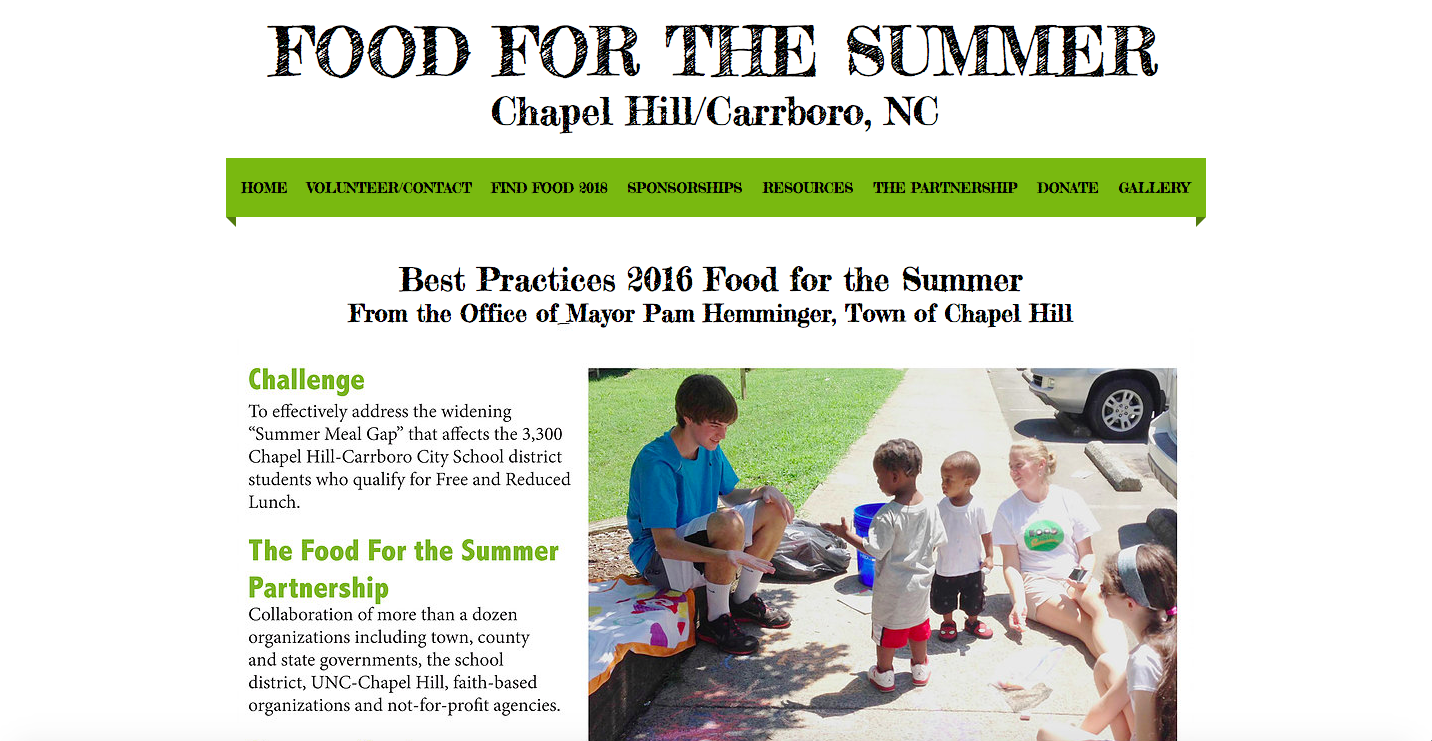Food for the Summer is a program that was introduced in the Chapel Hill and Carrboro communities of North Carolina in the summer of 2016. During the school year, almost 3,000 children receive free and reduced lunch in the area [1]. In consideration of the summer months being a challenging time for children to obtain consistently healthy lunches each day, the Food for the Summer program supplies these children with free meals and fun activities during the months of June to August.
Food for the Summer works with food service employees from three local school cafeterias to make healthy meals, which are then transported to meal sites by volunteers. During late August, the role of preparing and packaging the food is passed down to the food bank of central and eastern North Carolina [2]. As deliveries, meals, and activities are taking place on weekdays from 11:30 am until 1 pm, children up to the age of 18 line up to receive food with no need to show identifying information or qualifying paperwork. [3]
To execute their mission, Food for the Summer works with 11 organizations to establish community sites for food distribution. Among these organizations are, No Kid Hungry NC, Chapel Hill’s Mayor’s office, PORCH, and more [4]. This large collaboration is comprised of over 650 weekday volunteers who serve a total of 48,000 meals each summer at 13 food sites in Chapel Hill and 2 food sites in Carrboro [5]. Numerous sponsors also equip Food for the Summer with the means to accomplish their goal of administering meals, involving children in summer games and crafts, and presenting them with treats to take home and enjoy [6].
Food for the Summer has played a major role in Chapel Hill for the three years because it is a source for free healthy meals that relieves the pressure of low-income families as they that struggle to provide meals and other living necessities. In previous years, households who struggled with food insecurity looked for the cheapest and most viable food choices to feed their family, which meant that children were not always getting the proper nutrition they needed for their growing bodies. In addition, if parents were still not able to afford the cheapest and unhealthiest food options, their child could have remained hungry until their guardian found a manner to feed them. Food for the Summer is important in understanding Chapel Hill because it has restored a healthy balance that had long been missing in the food story. In providing meals, Food for the Summer is contributing to lowering obesity rates and poor health. This program provides children with what could be the only meal a child will have in a day. Due to the efforts of Food for the Summer, 120 to 150 children have been enrolled in the backpack program, which provides children with weekend meals [7]. The meals that the children eat as part of the program, not only contribute to their balanced diet, but educate the students on the importance of consuming nutritious foods. The summer program has changed the future for low-income families by providing a reliable and free food source that supports struggling families. As a result of Food for the Summer, no child has been left hungry during the summer months in Chapel Hill and Carrboro. This program marks the beginning of an era that truly leaves no child without nutritious meals year-round.
Footnotes:
- “Chapel Hill-Carrboro City Schools,” Plans and Reports: Opening of School Report 2017, https://www.chccs.org (11/4/18).
- “Best Practices 2016 Food for the Summer.” Food for the Summer, foodforthesummer.org/ (11/2/18).
- Ibid.
- “The Partnership.” Food for the Summer. foodforthesummer.org/ (11/3/18).
- “Food for the Summer.” Food for the Summer, foodforthesummer.org/ (11/4/18).
- Ibid.
- “Best Practices 2016 Food for the Summer.” Food for the Summer.
– Sofia Perez
